 W
WA watch is a portable timepiece intended to be carried or worn by a person. It is designed to keep a consistent movement despite the motions caused by the person's activities. A wristwatch is designed to be worn around the wrist, attached by a watch strap or other type of bracelet, including metal bands, leather straps or any other kind of bracelet. A pocket watch is designed for a person to carry in a pocket, often attached to a chain.
 W
WAn analog watch (American) or analogue watch is a watch whose display is not digital but rather analog with a traditional clock face. The name is an example of a retronym; it was coined to distinguish analog watches, which had simply been called "watches", from newer digital watches. It strictly refers to the design of the display, regardless of the timekeeping technology used within the watch movement or module, although its counterpart, "digital watch", usually connotes digital electronics in both. A digital watch is one in which the time is displayed as a series of digits, e.g. "04:32". An analog watch is one in which the display is not digital, but is indicated (typically) by the continuous motion of one, two, or three rotating pointers or hands pointing to numbers arrayed on a circular dial.
 W
WAutomatic quartz is a collective term describing watch movements that combine a self-winding rotor mechanism to generate electricity with a piezoelectric quartz crystal as its timing element. Such movements aim to provide the advantages of quartz without the inconvenience and environmental impact of batteries. Several manufacturers employ this technique.
 W
WAn automatic watch, also known as self-winding watch or simply automatic, is a mechanical watch in which the natural motion of the wearer provides energy to wind the mainspring, making manual winding unnecessary if worn enough. It is distinguished from a manual watch in that a manual watch, likewise having no internal battery, must have its mainspring wound by hand at regular intervals.
 W
WA braille watch is a portable timepiece used by the blind or visually impaired to tell time. It is used by touching the dial and noticing the embossments. Both analog and digital versions are available. The analog versions have a protective glass or crystal cover that is flipped open when time needs to be read and the clock-hands are constructed to not be susceptible to movement at the mere touch of the finger that a blind person uses to observe their positions. In the digital form, the dots keep changing position as time changes. In this case, one must understand the Braille alphabet to read the watch.
 W
WA calculator watch is a digital watch with a built-in calculator, usually including buttons on the watch face. Calculator watches were first introduced in the 1970s and continue to be produced, despite falling from their peak popularity during the 1980s. The most dominant brands in the end was the Casio Databank series and Timex.
 W
WThe Chinese Standard Movement, also commonly known as the "Tongji" movement, is a mechanical watch movement that was developed in the People's Republic of China during its fourth Five-Year Plan in the 1970s. It was designed by engineers from several early Chinese watch factories as part of a Ministry of Light Industry initiative to consolidate the industry, and with a few exceptions it became mandatory for all factories to discontinue the production of their own movements and to mass-produce the standard movement. Because of this, the production of the standard movement defines an entire era in the history of Chinese watchmaking. Once the most commonly produced mechanical/automatic watch movements in China, the numbers produced and their quality have since declined significantly; today the movement lives on typically in simple automatic and skeletonized variants, usually installed in cheaply produced watches made in China as well.
 W
WA chronograph is a specific type of watch that is used as a stopwatch combined with a display watch. A basic chronograph has an independent sweep second hand and a minute sub-dial; it can be started, stopped, and returned to zero by successive pressure on the stem. More complex chronographs use additional complications and can have multiple sub-dials to measure seconds, minutes, hours and even tenths of a second. In addition, many modern chronographs use moveable bezels as tachymeters for rapid calculations of speed or distance. Louis Moinet invented the chronograph in 1816 for use in tracking astronomical objects. Chronographs were also used heavily in artillery fire in the mid to late 1800s. More modern uses of chronographs involve aircraft piloting, auto racing, diving and submarine maneuvering.
 W
WThe Chronomat is a trademark and collection line from Breitling SA first released in 1941 and is one of the company's best selling models.
 W
WA chronometer is a specific type of mechanical timepiece. In Switzerland, only timepieces certified by the Contrôle Officiel Suisse des Chronomètres (COSC) may use the word certified chronometer or officially certified chronometer on them. Outside Switzerland, equivalent bodies, such as the Japan Chronometer Inspection Institute, have in the past certified timepieces to the same internationally recognised standards, although use of the term has not always been strictly controlled.
 W
WA coin watch or medal watch comprises a watch inserted into a coin or medal.
 W
WA computus clock is a clock equipped with a mechanism that automatically calculates and displays, or helps determine, the date of Easter. A computus watch carries out the same function.
 W
WThe Contrôle Officiel Suisse des Chronomètres (COSC), the Official Swiss Chronometer Testing Institute, is the institute responsible for certifying the accuracy and precision of Swiss watches.
 W
WA counterfeit watch is an unauthorised copy of an authentic watch. High-end luxury watches such as Rolex, Patek Philippe and Richard Mille are frequently counterfeited and sold on city streets and online. With technological advancements, many non-luxury and inexpensive quartz watches are also commonly counterfeited.
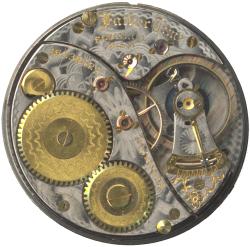 W
WIn horology, damaskeening is decorative patterning on a watch movement. The term damaskeening is used in America, while in Europe the terms used are Fausses Côtes, Côtes de Genève or Geneva Stripes. Such patterns are made from very fine scratches made by rose engine lathe using small disks, polishing wheels or ivory laps. These patterns look similar to the results of a spirograph or Guilloché engraving.
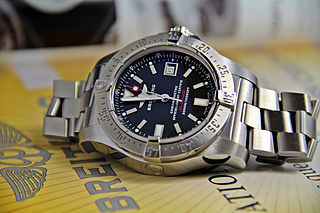 W
WA diving watch, also commonly referred to as a diver's or dive watch, is a watch designed for underwater diving that features, as a minimum, a water resistance greater than 1.0 MPa (10 atm), the equivalent of 100 m (330 ft). The typical diver's watch will have a water resistance of around 200 to 300 m, though modern technology allows the creation of diving watches that can go much deeper. A true contemporary diver's watch is in accordance with the ISO 6425 standard, which defines test standards and features for watches suitable for diving with underwater breathing apparatus in depths of 100 m (330 ft) or more. Watches conforming to ISO 6425 are marked with the word DIVER'S to distinguish ISO 6425 conformant diving watches from watches that might not be suitable for actual scuba diving.
 W
WA dollar watch was a pocket watch or later, a wristwatch, that sold for about one US dollar.
 W
WDouble chronograph is a watch that includes two separate stopwatch mechanisms in order to estimate two separate events of different durations. It is often confused with the flyback chronograph.
 W
WEco-Drive is a model range of watches manufactured and marketed worldwide by Citizen Watch Co., Ltd., powered primarily by light. As of 2007, the company estimated the drive system had eliminated the disposal of ten million batteries in North America.
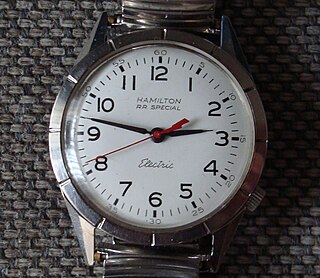 W
WIn horology, the term electric watch is used for the first generation electrically-powered wristwatches which were first publicly displayed by both Elgin National Watch Company and Lip on March 19, 1952, with working laboratory examples in Chicago and Paris. The Hamilton Watch Company would be the first to produce and retail an electric watch beginning in 1957, before the commercial introduction of the quartz wristwatch in 1969 by Seiko with the Astron. Their timekeeping element was either a traditional balance wheel or a tuning fork, driven electromagnetically by a solenoid powered by a battery. The hands were driven mechanically through a wheel train. They were superseded by quartz watches, which had greater accuracy and durability due to their lower parts count. Recent automatic quartz watches, which combine mechanical technology with quartz timekeeping, are not included in this classification.
 W
WA flyback chronograph is a complication watch, in which the user can use the reset function without the need to first stop the chronograph. In regular chronographs, the user must stop, reset, and restart the chronograph in order to time an event after the chronograph has started.
 W
WA folding clasp or deployant clasp or deployant buckle is a device used to close a watch strap.
 W
WThe Geneva drive or Maltese cross is a gear mechanism that translates a continuous rotation movement into intermittent rotary motion.
 W
WThe Geneva Seal (English), Poinçon de Genève (French), or Genfer Siegel (German) is the official seal of the City and Canton of Geneva, Switzerland. When a variation of the official seal is applied to wristwatch movements, the Geneva Seal is the quality seal of the Watchmaking School of Geneva and it has an official purpose as defined by the law.
 W
WThe history of watches began in 16th-century Europe, where watches evolved from portable spring-driven clocks, which first appeared in the 15th century.
 W
WThe history of watches began in 16th-century Europe, where watches evolved from portable spring-driven clocks, which first appeared in the 15th century.
 W
WThe Incabloc shock protection system is the trade name for a spring-loaded mounting system for the jewel bearings that support the balance wheel in a mechanical watch, to protect the wheel's delicate pivots from damage in the event of physical shock, such as if the watch is dropped. It was invented in 1934 by Swiss engineers Georges Braunschweig and Fritz Marti, at Universal Escapements, Ltd, of La Chaux-de-Fonds, Switzerland. It is manufactured by Incabloc, S.A. Similar systems are ETA's Etachoc, Kif, Seiko's Diashock, and Citizen's Parashock.
 W
WThis list of most expensive watches sold at auction documents the watches sold at auction worldwide for at least 1.5 million US dollars. The final price listed includes the buyer's premium paid to the auction houses, and has been converted to US dollars, if needed, according to the currency exchange rate at the time of auction. Inflation-adjusted prices are also listed for reference. If a watch has been sold at auction for several times, only the highest final price is included. Finally, any auctioned watch without public online records from auctioneers will not be included in the ranking.
 W
WLume is a short term for the luminous phosphorescent glowing solution applied on watch dials. There are some people who "relume" watches, or replace faded lume. Formerly, lume consisted mostly of radium; however, radium is radioactive and has been mostly replaced on new watches by less bright, but less toxic compounds.
 W
WA mechanical watch is a watch that uses a clockwork mechanism to measure the passage of time, as opposed to quartz watches which function electronically via a small battery, or radio watches, which are quartz watches synchronized to an atomic clock via radio waves. A mechanical watch is driven by a mainspring which must be wound either periodically by hand or via a self-winding mechanism. Its force is transmitted through a series of gears to power the balance wheel, a weighted wheel which oscillates back and forth at a constant rate. A device called an escapement releases the watch's wheels to move forward a small amount with each swing of the balance wheel, moving the watch's hands forward at a constant rate. The escapement is what makes the 'ticking' sound which is heard in an operating mechanical watch. Mechanical watches evolved in Europe in the 17th century from spring powered clocks, which appeared in the 15th century.
 W
WA watch is a portable timepiece intended to be carried or worn by a person. It is designed to keep a consistent movement despite the motions caused by the person's activities. A wristwatch is designed to be worn around the wrist, attached by a watch strap or other type of bracelet, including metal bands, leather straps or any other kind of bracelet. A pocket watch is designed for a person to carry in a pocket, often attached to a chain.
 W
WA mystery watch is a generic term used in horology to describe a watch whose working is not easily deducible, because it seems to have no movement at all, or the hands do not seem to be connected to any movement, etc.
 W
WThe O'Hara Waltham Dial Company is a historic factory building at 74 Rumford Avenue in Waltham, Massachusetts. The three story brick structure was built in 1897 by Daniel O'Hara, and housed his company, a spinoff from the Waltham Watch Company which specialized in the manufacture of a variety of clock faces. The building has distinctive corner towers with panelled brick surfaces, although these are a later addition. O'Hara's company operated until the late 1950s; the facility was then used in the manufacture of traffic signals and luggage.
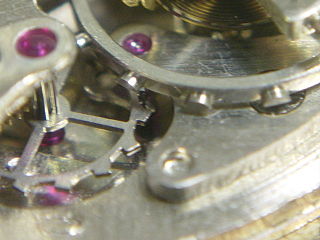 W
WA Roskopf, pin-lever, or pin-pallet escapement is an inexpensive, less accurate version of the lever escapement, used in mechanical alarm clocks, kitchen timers, mantel clocks and, until the 1970s, cheap watches now known as pin lever watches. It was patented by German watchmaker Georges Frederic Roskopf in 1867, suggested to Roskopf by Jules Grossmann.
 W
WA pocket watch is a watch that is made to be carried in a pocket, as opposed to a wristwatch, which is strapped to the wrist.
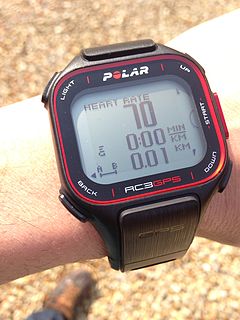 W
WA pulse watch, also known as a pulsometer or pulsograph, is an individual monitoring and measuring device with the ability to measure heart or pulse rate. Detection can occur in real time or can be saved and stored for later review. The pulse watch measures electrocardiography data while the user is performing tasks, whether it be simple daily tasks or intense physical activity. The pulse watch functions without the use of wires and multiple sensors. This makes it useful in health and medical settings where wires and sensors may be an inconvenience. Use of the device is also common in sport and exercise environments where individuals are required to measure and monitor their biometric data.
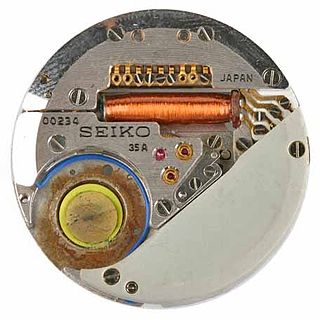 W
WIn watchmaking, the quartz crisis is the upheaval in the industry caused by the advent of quartz watches in the 1970s and early 1980s, that largely replaced mechanical watches around the world. It caused a significant decline of the Swiss watchmaking industry, which chose to remain focused on traditional mechanical watches, while the majority of the world's watch production shifted to Asian companies such as Seiko, Citizen, and Casio in Japan that embraced the new electronic technology.
 W
WA radio clock or radio-controlled clock (RCC), and often (incorrectly) referred to as an atomic clock is a type of quartz clock or watch that is automatically synchronized to a time code transmitted by a radio transmitter connected to a time standard such as an atomic clock. Such a clock may be synchronized to the time sent by a single transmitter, such as many national or regional time transmitters, or may use the multiple transmitters, or may use the multiple transmitters used by satellite navigation systems such as Global Positioning System. Such systems may be used to automatically set clocks or for any purpose where accurate time is needed. RC clocks may include any feature available for a clock, such as alarm function, display of ambient temperature and humidity, broadcast radio reception, etc.
 W
WA skeleton watch is a mechanical watch in which all of the moving parts are visible through either the front of the watch, the back of the watch or a small cut outlining the dial.
 W
WA solar-powered watch or light-powered watch is a watch that is powered entirely or partly by a solar cell.
 W
WThe Spring Drive is a watch movement conceived in 1977 by Yoshikazu Akahane at Suwa Seikosha. Specified to one second accuracy per day, the movement uses a conventional gear train as in traditional mechanical watches, but rather than an escapement and balance wheel, instead features Seiko's Tri-synchro Regulator system in which power delivery to the watch hands is regulated based on a reference quartz signal.
 W
WSwiss made is a label or marker used to indicate that a product was made or assembled on the territory of Switzerland. According to the Swiss Federal Act on the Protection of Trade Marks and Indications of Source, a good or service may be designated "Swiss made" if:For food products: 80% of the weight of the raw materials and the essential processing must take place in Switzerland. For industrial products: 60% of the manufacturing costs and the essential manufacturing step must occur in Switzerland. For services: the company headquarters and administration must be located in Switzerland.
 W
WA tachymeter is a scale sometimes inscribed around the rim of an analog watch with a chronograph. It can be used to conveniently compute the frequency in hours of an event of a known second-defined period, such as speed based on travel time, or measure distance based on speed. The spacings between the marks on the tachymeter dial are therefore proportional to 1⁄t, where t is the elapsed time.
 W
WThe Trench watch (wristlet) was a type of watch that came into use by the military during World War I, as pocket watches were not practical in combat. It was a transitional design between pocket watches and wristwatches, incorporating features of both.
 W
WA watch strap, watch band, watch bracelet or watch belt is a bracelet that straps a wrist watch onto the wrist. Watch straps may be made of leather, plastic, rubber, cloth, or metal, sometimes in combination. It can be regarded as a fashion item, serving both a utilitarian and decorative function. Some metal watch straps may be plated with, or even in rare cases made of, precious metals.
 W
WA watch timing machine or timegrapher is a machine that acoustically measures the ticks of a watch so that its accuracy can be measured and effectively calibrated. This device calculates the amplitude, beat rate, and beat error of a watch, and provides a summary of these figures after the watch is connected to the device for a fixed interval of time. The information recorded by this instrument is used by horologists and watchmakers to help determine if the timepiece's movement is in need of servicing, or a complete overhaul to restore its timekeeping accuracy. It is also used to determine if a newly produced timepiece is accurate, prior to being sold or released.
 W
WWater Resistant is a common mark stamped on the back of wrist watches to indicate how well a watch is sealed against the ingress of water. It is usually accompanied by an indication of the static test pressure that a sample of newly manufactured watches were exposed to in a leakage test. The test pressure can be indicated either directly in units of pressure such as bar, atmospheres, or as an equivalent water depth in metres.
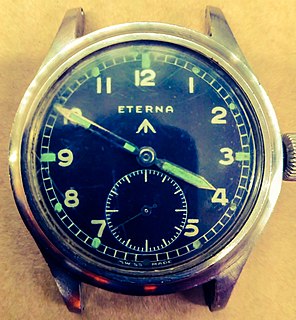 W
WThe waterproof wristlet watch was a type of watch manufactured in Switzerland and issued to British military forces after 1945. The (WWW) standard for wristwatches by the Ministry of Defence is believed to be one of the first official standards for a military issue watch.
 W
WA watch is a portable timepiece intended to be carried or worn by a person. It is designed to keep a consistent movement despite the motions caused by the person's activities. A wristwatch is designed to be worn around the wrist, attached by a watch strap or other type of bracelet, including metal bands, leather straps or any other kind of bracelet. A pocket watch is designed for a person to carry in a pocket, often attached to a chain.
 W
W